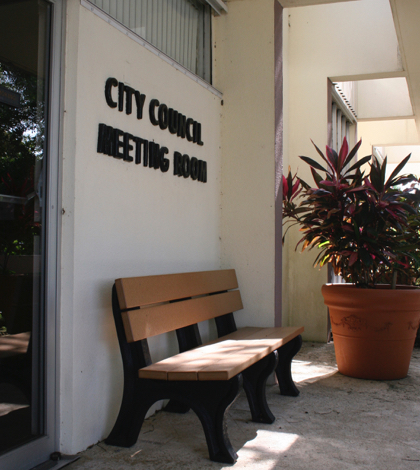Measure Q would divide the city into four districts, junking the at-large voting format the city has used since it incorporated nearly 40 years ago. A potential lawsuit alleging possible discrimination against minority voters prompted the move.
On Tuesday, Rancho Cucamonga voters will decide whether to switch to city council districts or continue electing their council members at large.
Measure Q, which the council voted in February to put on the ballot, would divide the city into four districts, with each to be represented by a resident from that area. The mayor would still be elected at large and would represent the entire city.
If voters say yes to Measure Q, two of the districts would go into effect in 2018, the remaining two in 2020, with all council members continuing to serve four-year terms.
Rancho Cucamonga incorporated in 1977, when the unincorporated communities of Alta Loma, Cucamonga and Etiwanda were merged, and it had a population of 171,058, according to the city’s website.
For the past several years, some city officials have discussed shifting to district representation, believing the city is large enough and diverse enough to support such a move, City Attorney James Markman said.
However, that’s not why Measure Q is on the ballot.
Like a number of California cities, Rancho Cucamonga has been threatened with a lawsuit if it did not convert to council districts, due to an alleged violation of the California Voting Rights Act, legislation bases on the U.S. Voting Rights Act that President Lyndon Johnson signed in 1965.
That threat came in the form of a letter in December from Shenkman & Hughes, a Malibu law firm, alleging that at large voting within the city is “racially polarized” and that minorities there are underrepresented.
In the Inland Empire, Banning, Hemet, Eastvale and Wildomar have all shifted to district representation recently under the threat of such a lawsuit.
“There are law firms that are making a cottage industry out of this thing,” Markman said. “They found a loophole in the state’s voting rights act and they’re going after it. The problem is, these lawsuits can be very expensive, and a city hasn’t won one of them yet.”
The other problem is the state’s voting rights act is very generous regarding the recovery of attorneys fees, a major factor if any municipality is considering fighting the issue in court.
“You pay your fees, and if you lose the case you also have to pay their fees,” Markman said. “That’s where these law firms are making their money.”
Supporters of council districts say they’re the best way to prevent voter dilution because they allow minorities to live close together and form coalitions. Opponents argue that cities that vote by district lead to city councils whose members are concerned only with their own area, not the entire city.
They also claim that districts keep some people from running for office because they have to wait four years for their district’s seat to open up. In an at-large system, anyone can run for any seat and there are vacant seats every two years because of staggered terms.
The threatened lawsuits, some of which ended up in court, started with school districts and migrated to cities, said Dane Hutchings, legislative representative with the League of California Cities in Sacramento and an authority on the state’s voting rights act.
“The state legislature has made it clear that it wants cities to go to districts, and the whole thing has grown from there,” Hutchings said. “In the case of Rancho Cucamonga, they were thinking about doing that anyway, and the threat of a lawsuit just moved things along for them a little bit faster.
“I think they’ve done a very good job with their public outreach, explaining to their residents what is going on.”
But Rancho Cucamonga shouldn’t have to explain anything because it’s not guilty of racially polarized voting or of allowing minorities to be underrepresented in local government or politics, Markman said.
Rancho Cucamonga’s city council currently has no Hispanic members, but two of its members – Mayor L. Dennis Michael and Mayor Pro Tem Sam Spagnolo, both white males – enjoy strong support in the city’s Hispanic community, Markman said.
Rancho Cucamonga voters also elected to Rex Gutierrez to four terms before he resigned in 2010. Even though Gutierrez stepped down after being convicted of several corruption-related felonies, the city can argue plausibly that it doesn’t have a history of discriminating against minority candidates.
None of that, however, would be enough to prevent the Rancho Cucamonga – whose Hispanic population was was 33.7 percent according to the 2010 U.S. Census, the most recent data available – from being sued under the state voting rights act.
“They can argue that Hispanic vote is being overwhelmed by the white vote, which is discriminatory,” said Markman, who has been Rancho Cucamonga’s city attorney since 1985. “We know the city has a large and growing Hispanic population, and it’s not underrepresented. No one is being discriminated against.
“Rancho Cucamonga is not Mississippi in 1964.”
The problem is that the law is vague about what makes up a substantial and growing minority population, leaving both sides to argue how to define those terms.
“It comes down to who hires the best demographers,” Markman said. “It’s all a display of charts and graphics. On the federal level, you can introduce a lot of factors – the legal term is totality of experience – but with the state it’s only about numbers.”
Those numbers are taken from voting patterns and demographic data in a city’s voting precincts, said Kevin Shenkman, principal with Shenkman & Hughes.
In court, both sides argue where those numbers intersect and whether minority groups have a fair opportunity to vote for the candidates of their choice. However, there’s no fixed percentage that helps determine if a specific group is being discriminated against, i.e., a 30 percent Latino population means there should be at least one Latino on the city council.
“It’s a complicated process, every case is different and every case is argued individually,” Shenkman said. “I can’t explain it. That’s why we have experts argue for us. But the numbers are the numbers, and they don’t know anything about ethnicity.”
District representation is more equitable toward minority groups because it assures those groups will have at least one elected official representing their interests, Shenkman said.
“In an at-large city you can have a 60 percent white population and 40 percent African American and the white candidates win all five council seats,” Shenkman said. “And after they take office they know they don’t have to worry about the African American community. That’s what happened in the south in the 1960s. The minority vote got overwhelmed.”
Rancho Cucamonga city council members are not commenting on Measure Q because the issue could still end up in court. Should voters reject Measure Q, the council in January could pass an ordinance that would bring about district voting, or it do nothing brace itself for more lawsuits and a possible courtroom battle.
“We will definitely see more lawsuits if it doesn’t pass,” Markman said. “I’ve heard some are already being prepared.”
 IE Business Daily Business news for the Inland Empire.
IE Business Daily Business news for the Inland Empire.


